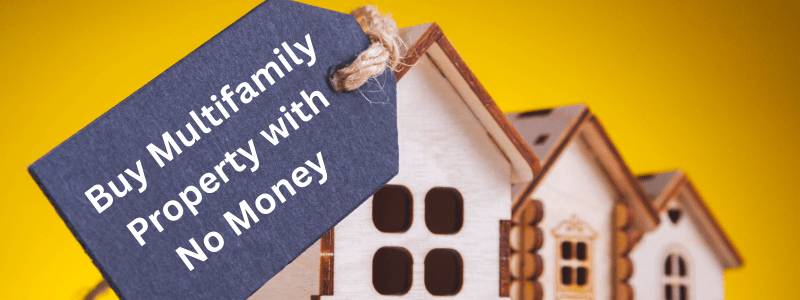
Why Buy Multifamily Properties with No Money Down?
Benefits of No Money Down Investments
Investing with no money down allows you to leverage other people’s money to grow your wealth. This approach minimizes your financial risk and allows you to diversify your investments. Additionally, it makes real estate investment accessible to those who might not have substantial savings but are eager to enter the market.
Common Misconceptions
Many believe that purchasing property without money down is a myth or only possible for seasoned investors. However, with the right knowledge and approach, even beginners can secure multifamily properties using creative financing methods.
Strategies to Acquire Multifamily Properties with No Money
Seller Financing
Seller financing is a popular strategy where the seller provides the buyer with a loan to purchase the property. This arrangement can benefit both parties: the seller gets regular payments, and the buyer doesn’t need traditional financing.
- How Seller Financing Works: Instead of getting a loan from a bank, you negotiate directly with the seller. Terms are flexible and can include interest rates, repayment schedules, and the loan’s duration.
- Negotiating Terms with Sellers: It’s crucial to present a solid business plan to the seller, showcasing your ability to manage the property and make timely payments. Building a rapport and trust with the seller can also be advantageous.
Lease Options
A lease option involves leasing a property with the option to buy it later. This method allows you to control the property and generate rental income without immediate ownership.
- Understanding Lease Options: You pay an option fee for the right to purchase the property at a later date, usually at a predetermined price. This period allows you to improve the property and secure traditional financing.
- Benefits and Drawbacks: While lease options can be a great way to enter real estate investing, they often come with higher monthly payments. Additionally, if you decide not to purchase, you may forfeit the option fee.
Partnering with Investors
Finding a partner with capital can provide the funds needed to purchase a multifamily property. In return, you offer your expertise and management skills.
- Finding the Right Partner: Look for investors who share your vision and goals. Networking at real estate events or joining investment groups can help you meet potential partners.
- Structuring the Partnership Agreement: Clearly outline each partner’s responsibilities and profit-sharing arrangements. A legal agreement can prevent misunderstandings and ensure a smooth partnership.
Using Private Money Lenders
Private money lenders are individuals who lend their own capital for real estate investments. These loans are typically short-term and come with higher interest rates.
- What Are Private Money Lenders?: Unlike traditional lenders, private money lenders are more flexible and can fund deals quickly. They are often looking for higher returns on their investment.
- How to Approach and Secure Private Money: Build a strong case for your investment, highlighting the property’s potential and your plan to generate returns. Networking and maintaining a good reputation in the real estate community can help attract private lenders.
Hard Money Loans
Hard money loans are similar to private money loans but are usually provided by companies specializing in real estate lending. These loans are asset-based, meaning the property serves as collateral.
- How Hard Money Loans Work: These loans are easier to obtain than traditional mortgages and are often used for short-term investments or property flips. However, they come with higher interest rates and fees.
- Pros and Cons of Hard Money Loans: While they offer quick funding and less stringent approval processes, the high cost can eat into your profits if the property doesn’t perform as expected.
Seller Second Mortgages
In a seller’s second mortgage, the seller provides a second mortgage to cover part of the purchase price. This method can bridge the gap between the primary loan and the total cost.
- What Are Seller Second Mortgages?: The seller agrees to finance a portion of the property’s price, usually in a junior position to the primary mortgage. This arrangement reduces the amount you need to borrow from traditional lenders.
- How to Negotiate a Seller Second Mortgage: Like seller financing, convincing the seller of your ability to manage the property and make payments is crucial. Detailed planning and transparent communication can help secure this type of financing.
Wholesaling Multifamily Properties
Wholesaling involves finding properties, getting them under contract, and then selling the contract to another investor. This strategy requires no money down as you’re not buying the property.
- The Wholesaling Process: Identify distressed or undervalued properties, negotiate a purchase contract, and then find a buyer willing to pay more than your contract price.
- Tips for Successful Wholesaling: Building a network of buyers and sellers is essential. Effective marketing and negotiation skills can significantly enhance your wholesaling success.
Real Estate Crowdfunding
Crowdfunding platforms allow you to pool funds from multiple investors to purchase a property. This method can help you invest in larger multifamily properties without significant personal capital.
- What is Real Estate Crowdfunding?: These platforms connect investors with real estate projects. You contribute a smaller amount of money, along with others, to fund a larger investment.
- Platforms and How to Get Started: Research various crowdfunding platforms to find those that align with your investment goals. Platforms like RealtyMogul offer opportunities for multifamily investments.
Preparing to Buy a Multifamily Property

Building a Strong Network
Your network can be a valuable resource in finding deals and securing financing. Building relationships with other investors, real estate agents, and lenders can provide opportunities and support.
- Why Networking Matters: A strong network can provide leads on properties, partnerships, and financing options you might not find on your own.
- Tips for Effective Networking: Attend real estate events, join local investment clubs, and participate in online forums. Be genuine in your interactions and look to provide value to others.
Enhancing Your Credit Score
A good credit score can improve your chances of securing favorable financing terms. It’s important to monitor and improve your credit if necessary.
- Importance of Credit in Real Estate: Lenders use your credit score to assess your risk as a borrower. A higher score can lead to better loan terms and lower interest rates.
- Steps to Improve Your Credit Score: Pay down debts, correct any errors on your credit report, and avoid applying for new credit before seeking a loan.
Educating Yourself
Knowledge is power in real estate investing. Continuous learning can help you stay ahead of market trends and make informed decisions.
- Learning About Real Estate Investment: Read books, take courses, and follow industry blogs to deepen your understanding of real estate investing.
- Resources for Continuous Learning: Books like “Rich Dad Poor Dad” by Robert Kiyosaki and online courses from platforms like Coursera can be valuable resources.
Potential Risks and How to Mitigate Them
Investing with no money down can be risky. It’s essential to understand these risks and develop strategies to manage them.
- Common Risks in No Money Down Investments: These can include over-leveraging, property underperformance, and market fluctuations.
- Strategies for Risk Management: Diversify your investments, perform thorough due diligence, and have contingency plans in place.
Conclusion
Buying a multifamily property with no money down is challenging but possible with the right approach. By leveraging creative financing strategies, building a strong network, and continuously educating yourself, you can enter the real estate market and grow your wealth. Start exploring these methods today and take the first step toward achieving your investment goals.
FAQs
1. Can I buy a multifamily property with no money down?
Yes, with the right strategies such as seller financing, lease options, and partnering with investors, it’s possible to buy a multifamily property with no money down.
2. What is the best strategy for a beginner?
Seller financing and partnering with experienced investors are often good starting points for beginners.
3. How do I find private money lenders?
Networking at real estate events, joining investment clubs, and leveraging online platforms can help you connect with private money lenders.
4. Are there risks involved in no money-down investments?
Yes, common risks include over-leveraging and property underperformance. It’s important to perform due diligence and have risk management strategies in place.
5. How long does it take to close a no-money-down deal?
The timeline varies depending on the strategy used and the complexity of the transaction. It can range from a few weeks to several months.
To learn more about effective financial management, check out our detailed guide on What Is Budgeting and Why Is It Important?
